Forex brokers get compensated for providing trading services to traders. This compensation is through different trading fees and charges.
There are basically three trading charges. One of them is the spread, and the others include commissions & swap fees.
Forex and other CFDs have two price quotes – the bid price and the ask price. The Spread is the difference between the bid and the ask price. The spread cost is measured in pips.
CFD brokers have different pricing and fees condition. Some charge swap and commission. Some charge one of the two or either. However, there is no broker that does not charge a spread on their CFD instruments.
As a trader, you have to know that the higher the spread, the higher the charges you incur. This is why we have reviewed for you, the best low spread brokers in Australia.
Let’s see how they compare below.
Comparison of Best Low Spread Forex Brokers in Australia
| Broker | ASIC Regulated | AUD/USD Spread (pips) | Commission | Visit |
|---|---|---|---|---|
| Pepperstone |
Yes
|
0.84 (Standard Account)
|
AUD3.50 per standard lot (Razor Account)
|
Visit Broker |
| IC Markets |
Yes
|
0.77 (Standard Account)
|
AUD3.50 per standard lot (Raw Spread Account)
|
Visit Broker |
| FP Markets |
Yes
|
1.4 (Standard Account)
|
$3 per standard lot (Raw ECN Account)
|
Visit Broker |
| eToro |
Yes
|
1.00
|
No commission
|
Visit Broker |
Note: The spread data & commission is as per information on these brokers’ websites in Apr. 2022.
Best Low Spread Brokers in Australia
Here is the list of the best low spread brokers in Australia that we have reviewed:
- Pepperstone – Forex Broker with Lowest Spreads in Australia
- IC Markets – Low Spread Broker with cTrader
- FP Markets – Low Spread Broker with ASIC Regulation
- eToro – Low Spread Broker with Copy Trading
- CMC Markets – Regulated Forex Broker with Low spreads for majors
Risk Warning: Low spreads only guarantee low charges. It does not guarantee the safety of your funds. Only trade with ASIC regulated brokers to keep your funds safe.
#1 Pepperstone – Forex Broker with Lowest Spreads in Australia
Pepperstone are regulated with ASIC so they are low-risk. Their two accounts – Razor Account and Standard Account come with different trading conditions and spread. The spread on the Razor Account is ECN type. The Standard Account has normal spreads.
Signing up with Pepperstone lets you open a Razor Account or Standard Account. The Razor Account has low average spreads for major pairs as shown below:
AUD/USD (0.24 pips), EUR/USD (0.17 pips), GBP/USD (0.59 pips), USD/CHF (0.49 pips), USD/CAD (0.47 pips), USD/JPY(0.26 pips), NZD/USD (0.52 pips).
If you choose the Razor Account, you will be paying a commission on your trades. The commission depends on your trading platform. On MT4/MT5, you will pay a commission of AUD 3.50 per standard lot (AUD 7 round-turn). On cTrader, the commission is $3 per standard lot.
You might also prefer the trading conditions on the Standard Account. Especially seeing that there is no extra commission per standard lot. However, the spreads are higher than that of the Razor Account. They are shown below:
AUD/USD (0.84 pips), EUR/USD (0.77 pips), GBP/USD (1.19 pips), USD/CHF (1.09 pips), USD/CAD (1.07 pips), USD/JPY(0.86 pips), NZD/USD (1.52 pips).
These trading conditions are competitive so the choice is yours. Razor Account or Standard Account.
#2 IC Markets – Low Spread Broker with cTrader
IC Markets are considered low risk because of their regulation with ASIC. They also offer two account types. A Raw Spread Account with ECN condition and a Standard Account. Apart from spreads, IC markets also charge swaps and commissions.
For IC Markets, the Raw Spread Account is ECN. The spreads come from about 25 institutional-grade investors. Also, there is no order distance restriction. The account is available on MT4, MT5, and cTrader with 61 currency pairs. IC Markets’ raw spreads for major currency pairs are listed below:
AUD/USD (0.17 pips), EUR/USD (0.02 pips), GBP/USD (0.23 pips), USD/CHF (0.19 pips), USD/CAD (0.25 pips), USD/JPY(0.14 pips), NZD/USD (0.38 pips).
You should also know that you will incur some charges if you choose this account. Spreads, Swap, and commission. You will pay them all. The swap for AUD/USD is AUD 2.3 (long) and AUD 1.1 (short). The commission depends largely on your choice of trading platform. The commission on MT4/MT5 is AUD 7 (round-turn). On cTrader, it is $6 (round-turn).
Now, let’s look at the Standard Account. The conditions are the same with the Raw Spread Account. The only difference is that the spreads are not raw. Also, there is no extra commission per standard lot and it is only available on MT4 and MT5 only.
You cannot open the Standard Account on cTrader.
The average spread for major pairs on the Standard Account is shown below:
AUD/USD (0.77 pips), EUR/USD (0.62 pips), GBP/USD (0.83 pips), USD/CHF (0.79 pips), USD/CAD (0.85 pips), USD/JPY(0.74 pips), NZD/USD (1.38 pips).
#3 FP Markets – Low Spread Broker with ASIC Regulation
FP Markets are regulated with ASIC (AFSL Number 286354). We consider them low-risk. FP Markets support MT4 and MT5 only. No other trading platforms. They also offer two accounts and charge swaps. The commission depends on your account type.
You have two choices as per account type. The Raw ECN Account or the Standard Account. Let us break the accounts down briefly.
The Raw Account has an ECN-pricing execution with low spreads for major pairs as shown below. The spread begins from 0.0 pips.
AUD/USD (0.3 pips), EUR/USD (0.2 pips), GBP/USD (0.4 pips), USD/CHF (0.5 pips), USD/CAD (0.4 pips),
USD/JPY(0.3 pips), NZD/USD (0.6 pips).
Other fees attached to the account include USD $3 per standard lot (USD $6 round-turn). You will also pay a swap for AUD/USD – (AUD-2.27 for long positions, AUD-1.02 for short positions).
There is no extra commission per lot for the Standard Account and the spread begins from 1.0 pips. You will pay a swap for your overnight trades as well.
You can find the average spread for major currency pairs below:
AUD/USD (1.4 pips), EUR/USD (1.3 pips), GBP/USD (1.5 pips), USD/CHF (1.7 pips), USD/CAD (1.5 pips),
USD/JPY(1.4 pips), NZD/USD (1.8 pips).
#4 eToro – Low Spread Broker with CopyTrading
We consider eToro low risk because they are regulated with ASIC. The forex broker offers just one account type. Though their spreads begin from 1 pip, eToro has comparatively high spreads. They do not charge an extra commission. But there are overnight charges
eToro offers 48 currency pairs with high spreads when compared to other brokers in this guide. Here is a glance at their typical spread for major fx pairs:
AUD/USD (1 pips), EUR/USD (1 pips), GBP/USD (2 pips), USD/CHF (1.5 pips), USD/CAD (1.5 pips),
USD/JPY(1. pips), NZD/USD (2.5 pips).
You will not incur any other trading fees other than the swaps. Also, if you compare eToro’s spread for NZD/USD to that of other forex brokers, that of eToro is higher (2.5 pips)
This is to further show you that eToro’s spreads are comparatively higher. Also, they have good conditions for copytrading.
What are Forex Spreads?
Spread is one of the ways CFD brokers make their money. When you place a trade, there is a difference between the price you are willing to pay for a currency pair and the price a seller is willing to sell. The difference between these two prices is referred to as the spread. You may be wondering how the spread which is measured in pips translates to money. We have this covered in a later section of this article.
The spread represents the broker’s fee for facilitating the trade. It’s usually expressed in pips, which is the smallest price movement for a particular currency pair. For example, a pip in EUR/USD is 0.0001.
Here’s an Example:
-Suppose the EUR/USD exchange rate is quoted at 1.1234/1.1238.
-The bid price is 1.1234 euros per US dollar.
-The ask price is 1.1238 euros per US dollar.
-The spread is 4 pips (1.1238 – 1.1234).
So, for every euro you buy at the ask price, you’re effectively paying 4 pips more than the price at which you could sell it (the bid price). This 4-pip spread represents the broker’s commission for executing the trade.
You may be wondering how the spread which is measured in pips translates to money. We have this covered in a later section of this article.
Here are the common spreads in forex trading
1) Variable spreads: A broker offers variable spreads if they pass on the best bid price at a certain time. The variability depends on the broker and the currency pair(s) or CFDs. Variable spreads are constantly changing and are cheaper when liquidity is high. However, they are subjected to high volatility due to economic news and macroeconomic events.
2) Fixed spreads: Fixed spreads are consistent. Most of the time, they remain unchanged regardless of market conditions. It is easier to plan your trading fees with fixed spreads because they are not constantly changing like variable spreads. It is important to note that fixed spreads can change dramatically during important news events. Other than this, they are constant.
What Should You Consider as a Low Spread?
There is not a specific figure that can be tagged as a low spread. However, there are factors you can consider to help you come to a conclusion. The first factor to consider is the currency pair or pairs you want to trade. Generally, major currency pairs have lower spreads compared to minor currency pairs. Exotic currency pairs have the highest spreads of all currency pairs.
Another factor you can consider, especially for major currency pairs, is the industry average. For example, the industry average spread for the EUR/USD 1 pip. Therefore, any forex broker that offers a spread below 1 pip for EUR/USD will be considered a low spread broker for EUR/USD. The only downside with this factor is that it does not apply to all currency pairs. A broker with a spread lower than the industry average for EUR/USD might have a spread higher than the industry average for GBP/USD. This is why you should take time to research the spreads of the brokers you want to choose.
Finally, you should consider the type of spread that your broker offers. It is essential to consider this factor because it helps you take advantage of low spreads and affect your trading time. If your broker offers a fixed spread. There is really nothing you can do than trade at any time. Variable spreads fluctuate and based on market conditions, they can be high or low. When there is no big news or huge macroeconomic events going on, variable spreads are usually low. This might be the best time for you to trade with low spreads.
How to Optimize Low Spreads
Low spreads are not a guarantee that conditions are favorable for trading. You have to combine your analysis with other minute details to take advantage of low spreads. Here is how you can do this:
1. Know the kind of spread offered by your broker (fixed or variable). If it is the latter, only trade when the spreads are low. That is, when there is no significant economic event going on.
2. Find out other trading fees. Especially commissions and swaps. They tend to increase your trading fees once they are added to the fees incurred from spreads.
3. Trade with low leverage. The higher your leverage, the higher your risk of a margin call. If the market moves against your trade, you will suffer a heavy loss to your capital.
How to Calculate Spread Costs
Spreads are trading fees. This means they affect your final profit or loss. This is why you should learn how brokers factor in spread costs in your overall trading fees.
Let us consider these hypothetical trading parameters. You want to buy 100,000 units (1 standard lot) of AUD/USD. The bid/ask price is 0.6933/0.6932 so your spread is calculated as:
0.6933-0.6932=0.0001 (1 pip)
Since you are buying a standard lot (100,000 units), your spread cost will be the number of units multiplied by the spread. Here is the calculation below
100,000 * 0.0001=$10.
For this trade, your spread cost is $10. This means when you open the trade, you begin with a $10. If you make a profit, the amount will be reduced by $10 when you close the trade. If your trade ends in a loss, an additional $10 will be incurred as spread cost.
So you see, the spread cost affects your trade whether you win or lose. This is why you should go for forex brokers with low spreads. Also, do not forget to check if the broker is regulated with the Australian Securities and Investments Commission (ASIC).
How to Check a Forex Broker’s Spread
Generally, forex brokers have their spreads on their websites. You only need to know how to find them. Before we walk you through it, know that it is good to check the spreads before opening your trading account.
Why?
Because spreads, like other trading fees, determine your final profit or loss when you close a trade. The essence of checking is for you to know if they are high or low.
Now let us proceed to our guide on how to check the spreads. Our example broker is FP Markets.
1) The first step is to enter the forex broker’s website. In this example, the website address is fpmarkets.com. This will bring you to the homepage.
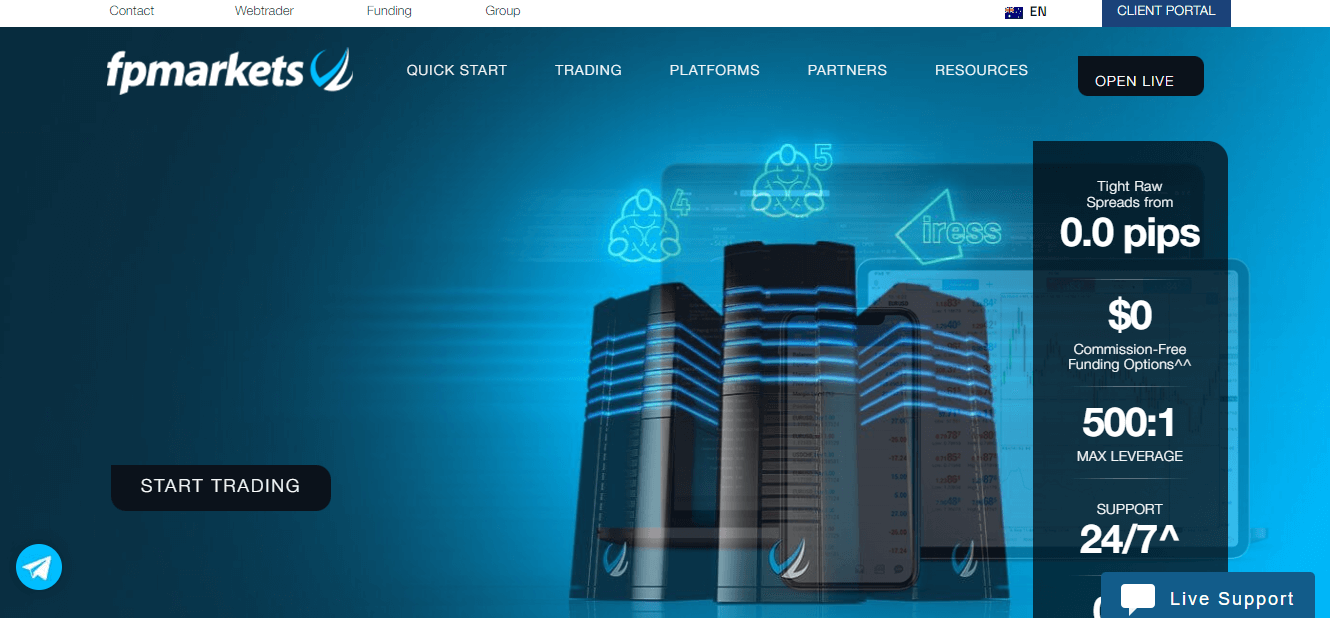
Can you see the Australian flag at the top right corner? That generally means that the website you are visiting is for Australian clients. It is important so you don’t end up checking the data of that broker for another country.
2) Click on “Trading” (in the yellow box). You will get a dropdown with different sections. Under the “Pricing” section, click on “Spreads” (in the red box).

3) If you follow step 2 accurately, you will arrive at the picture below after scrolling down a bit. There are some explanatory notes about spreads on the page. You will need to scroll past them to get here.
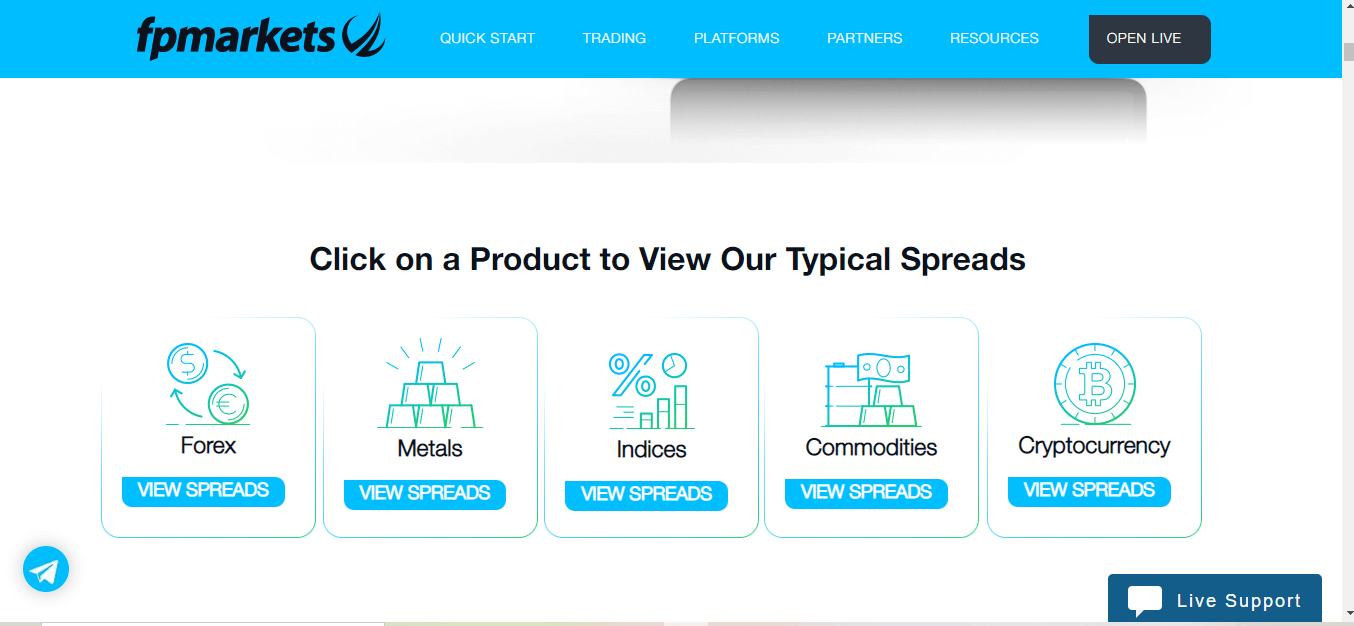
Here, click on the “view spreads” tab under forex.
4) You will find all the currency pairs and their spreads under the two account types. The page looks like the picture below:
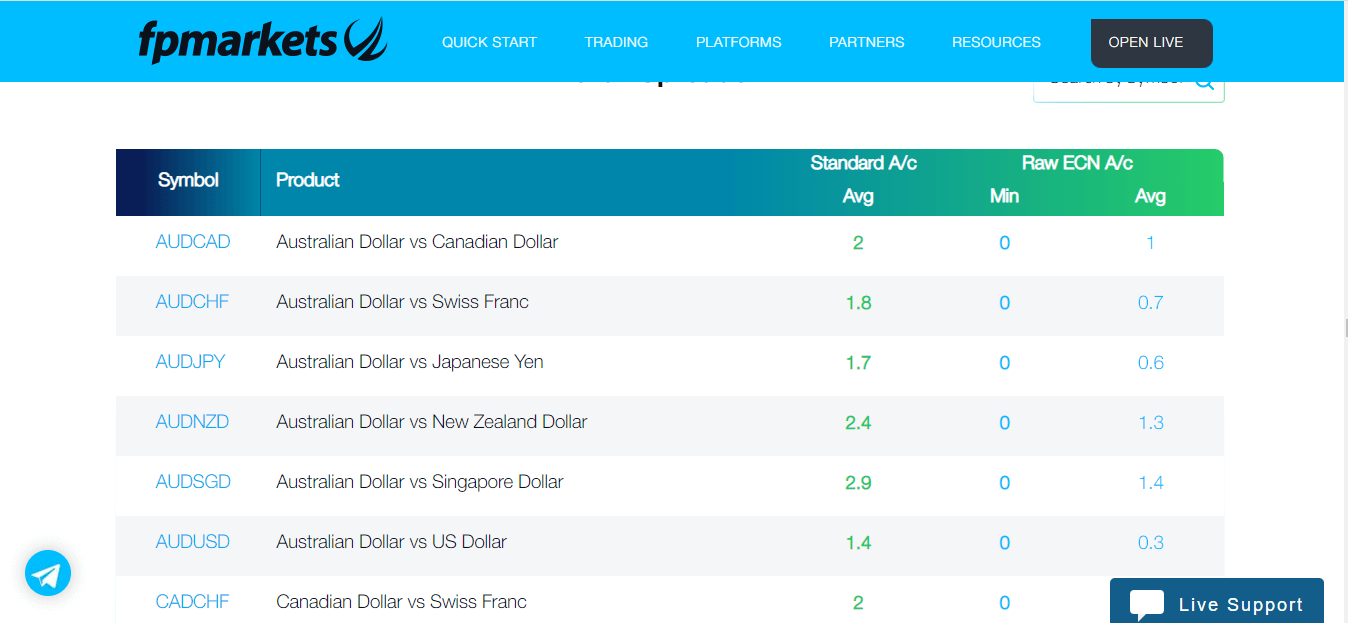
There are over 60 FX pairs in there. So use the “search bar” at the top right of the table for easy and quick navigation.
How to Choose a Low Spread Broker in Australia
In the previous section, we covered how you can check a broker’s spread. This is a major factor to consider when choosing a low spread broker. However, that is not the only factor you should look into. In this section, we cover the other important factors.
Regulation: Low spreads do not guarantee safety. Trading with a regulated broker only guarantees that. After confirming a forex broker has low spreads, you have to confirm if your funds are safe with them. This is done by verifying if your broker is regulated with ASIC. Here is how you can go about this using pepperstone as an example.
1) Check your broker’s regulation in the footnote of their website. Pay attention to the company name and AFSL number.

From the image, you can see that the company name is Pepperstone Group Limited with license number 414530. We need these details to correlate with the ones on ASIC’s website.
2) On ASIC’s register, enter the broker’s AFSL number and select Current as shown below.
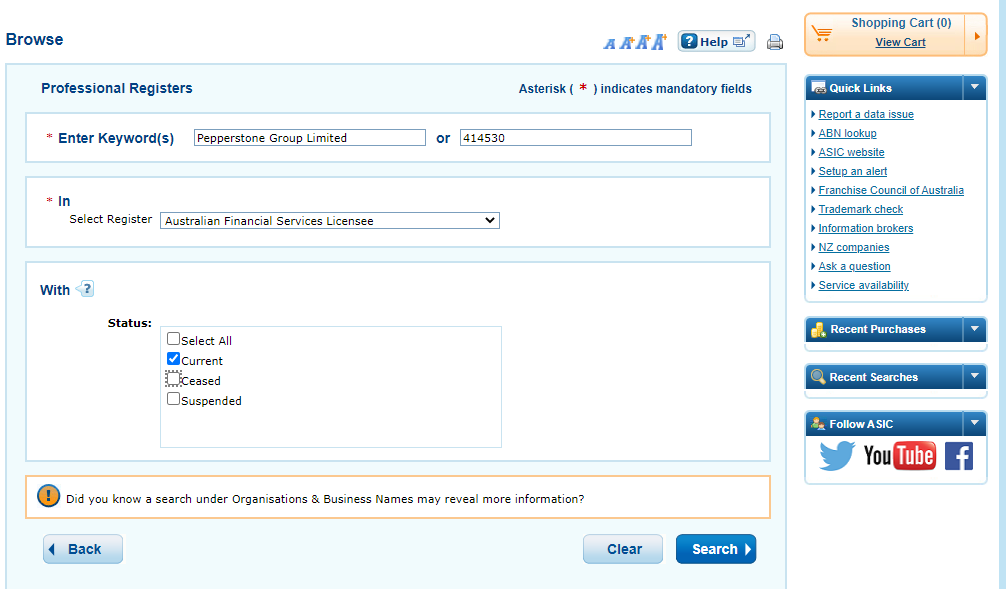
The final step is to click ‘Search’. The final result will look like the picture below

Under the licensee summary, you can see that the company name and AFSL number match the details from the broker’s website. This is how you verify the regulation for low spread brokers in Australia.
Account type: It is common for a broker to have more than one account. Usually, the spreads on these accounts will differ. If one of the accounts is a raw ECN-type account, the typical spreads are usually low. Since you are looking to choose a low spread broker, you might as well go for the accounts with the lowest spreads.
This is why you should check if your broker offers varying account types. Let us compare Pepperstone’s account as an example. Here is how their account looks.
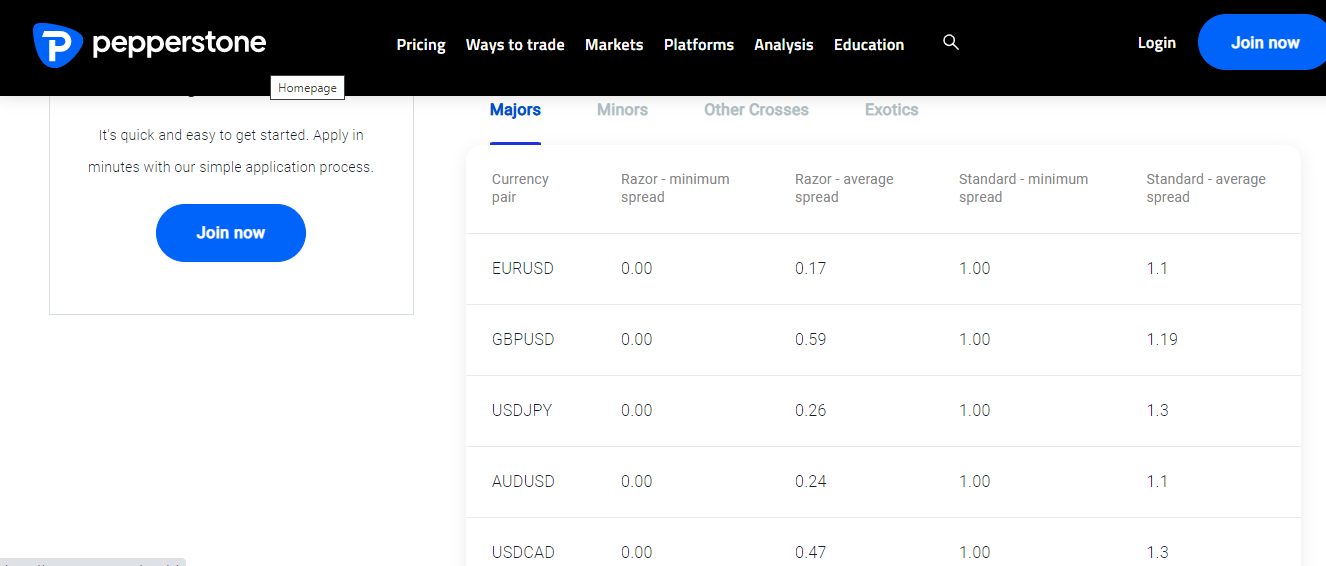
If you compare the average spreads for major pairs on the Razor and Standard Accounts, you will see a significant difference in the spreads. Summarily, low spreads are available on the Razor Account only. For the Standard Account, the spreads are much higher though there is no extra commission.
Comparing different accounts offered by brokers help you identify the account with low spreads easily.
Other trading fees: We have covered how to calculate spread costs. But spreads are not the only trading fees you incur. There are commissions and overnight charges too. For brokers with multiple account types, their ECN accounts usually combine low spreads with extra commission charges.
Let us explain this better with IC Market’s account types from the image below
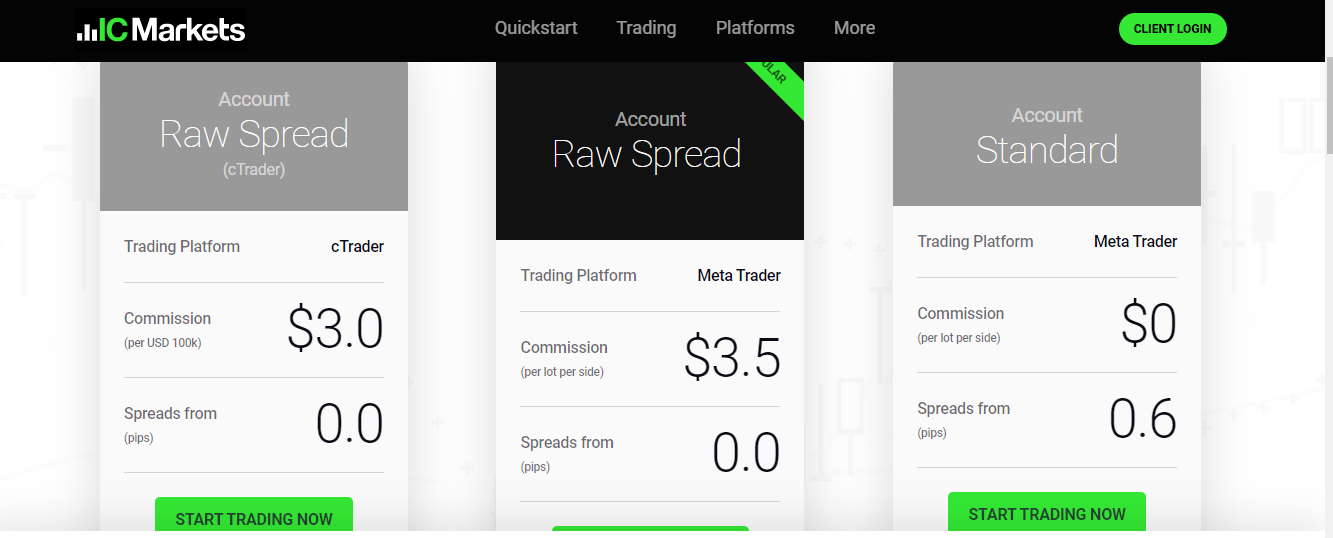
If you compare IC Market’s Raw Spread and Standard Accounts, you will see that the spreads on the former is low beginning from 0.0 pips. The Standard Account has higher spreads beginning from 0.6 pips. For commissions, there is none charged on the Standard Account. On the Raw Spread Account (MT4/MT5), you will pay $3.5 per standard lot. If you choose the Raw Spread Account (cTrader), you will pay $3.0 per side.
Swaps can be high or low depending on the broker. These fees determine your total loss or profit per trade. This is why you have to check them to know if they are high or low.
Platforms: Before choosing a broker with low spreads, you should consider their trading platforms. Does the broker support MT4/MT5 which are the most common trading platforms?
Are there other third-party platforms like cTrader and TradingView with advanced technical tools?. Furthermore, you want to make sure that they have platforms that you can use on multiple devices and operating systems. You should be able to trade on desktops, tablets, and mobile phones as you see fit.
Finally, the trading platforms should function well on android, windows, and the iOS.
Customer Service: You want to make sure you are in good hands when dealing with a forex broker. You may have issue with your deposit/withdrawals. Or need more information about your broker’s trading conditions. So you need to know the channels of communication your broker supports.
Are there FAQs? Can you speak to a live customer support agent? Are email responses quick? These are the questions you should have in mind as you choose a low spread broker. You should also test all of their customer service channels to know how effective and fast they are.
What is a Zero Spread Trading Account?
A zero spread trading account is an account that has no significant difference between the bid (sell) and ask (buy) prices for certain currency pairs. Forex brokers do not offer zero spread on all of their currency pairs. It is easy to see why because forex brokers make money from spreads. In addition, some currency pairs do have enough liquidity that may allow for zero spread.
So, if a broker offers a zero account, it will usually be for major currency pairs like GBPUSD and EURUSD. These pairs have high trading volumes and are liquid. Since a zero account likely means zero spread cost, it does not mean you are not incurring other trading costs. Your forex broker might charge a commission or have other hidden fees.
Therefore, it is important you do your research if you see a forex broker offering a 0 spread account. Make sure you find out the structure of their trading costs before opening an account.
Which Spread is Best for Forex Traders?
Forex trading is is a complex and diverse enterprise. The answer to this question is not that straightforward. The best spread for forex depends on your choices, your trading style, and strategies. Different forex trading strategies have different spreads that suits them.
Let us consider some of these strategies.
Scalping: Scalping involves opening and closing trades quickly to accumulate little profits over a period of time. Too high spreads defeats this purpose so low spreads are best for scalpers. Very low spreads positively impact their profitability.
Day trading: Day traders will definitely prefer lower spreads but can make do with slightly higher spreads. This is possible because of how long they hold their trades.
Swing trading: Swing traders do not mind wider spreads. They can have trades open for up to a month or more. Their trades will pass through periods of volatility including the widening of spreads during high impact economic news.
As long as a swing traders have an edge in their trading, they will likely not worry about these scenarios.
Position traders: Position traders are not too concerned with spreads. They have an investment approach that to trading, focusing on long-term, larger price movements. For these traders, spread is not a very strong factor.
What is the difference between a standard account and a raw spread account?
A standard account typically refers to the standard lot size (100,000 units). It indicates the smallest trade size.
Raw spread refers to the cost of trading without any mark up from your broker. This means the bid/ask price of the account comes directly from your broker’s liquidity providers.
What is the difference between zero commission and raw spread?
Zero commission brokers do not charge commission. However, they usually add a mar-up to the spreads they receive from liquidity providers.
Raw spread brokers offer spreads that are not marked up. However, they charge commissions per standard lot.
Are trading fees low with low spread brokers
It depends on the forex broker’s fee structure. If a broker has an account with low spread, that account is likely a raw spread or ECN type account. For these accounts, the commissions are usually high. They can be up to $3 per standard lot.
So what you have is a combination of low spread and commission as your trading fees? Whether the fees are high or low depends on you. It is more subjective than objective.
FAQs on the Best Low Spread Brokers in Australia
Which low spread broker is best in Australia?
Any forex broker with low spreads, especially ECN type account is the best. However, you should also verify if the forex broker is regulated with ASIC for the safety of your funds. ASIC Regulation with a Raw Spread Account is a good trading condition. According to our review, only Pepperstone, IC Markets, and FP Markets meet this criterion.
Which broker has the lowest spreads?
Out of the four brokers we compared in this guide, Pepperstone and IC Markets has the lowest spreads for major currency pairs. They have trading accounts with raw spreads from zero pips & are commission based.
Are low spreads good in forex?
Low spreads are good in the sense that they reduce costs incurred from spreads. However, low spreads do not reduce the risks associated with CFD trading. This is why you should only trade with low spread brokers that are ASIC regulated.
Is there any Zero Spread Forex Broker in Australia?
Zero Spreads generally mean the CFD broker will charge some sort of commissions to make profits from clients. For example, Australia forex brokers like IC Markets, FP Markets & Pepperstone, all have Raw spreads trading accounts, which generally have spreads from zero pips for majors. But there is an extra commission per lot.
For example, with Razor Account, the minimum spread for EUR/USD is 0 pips (0.17 on average), and the commission per lot is AUD 7 round turn (if your account base currency is AUD).
Which forex broker has the tightest spreads?
Pepperstone and IC Markets have tight spreads for major FX pairs in Australia. For example, the typical spread for a major pair like EUR/USD is 0.77 pips with Standard Account at Pepperstone, and there is no extra commission per lot.



